
RESEARCH


BUSINESSES 5
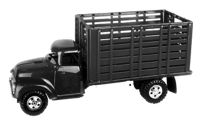





Darrtown
Phone Co.
Bufler's
Jewelry
Teckman
Trucking
Cartwright-Uhl
Trucking
Fisherman
Press
Dit-Dot
Paint Co.
The following timeline was compiled from newspaper clippings and entries in the L.A. Miller diaries.
1900 - From the Hamilton Telegraph
"Darrtown Telephone Company seeks "Right of Ways"
February 1, 1900
"The Darrtown Telephone Company, whose incorporation was recently noted in the REPUBLICAN-NEWS, has applied to county commissioners for a right-of-way to construct a line over the Hamilton and Richmond turnpike, from Hamilton, to Somerville, over the Oxford and Somerville turnpike, to Collinsville, over the Flenner turnpike, to Oxford, over the Oxford turnpike, and to Riley, by way of Woods Station. The application is signed by President Frank S. Bufler and John F. Mee, secretary."
1903 - From the Butler County Democrat
On February 5, 1903, the "Darrtown News" section of the Butler County Democrat newspaper reported, :
"Darrtown Telephone Company Stringing Wires
The Darrtown Telephone Company is stringing wires through Tucky Run this week."
Tucky Run flows northeast to southwest and empties into Darr's Run.
1933 - From the Hamilton Journal Daily News
Webmaster Notes:
[1] The business was located in the L.A. Miller home. See images in the following section.
[2] L.A. Miller's son was Ernest "Ernie" MIller and [3] L.A. Miller's wife was Eva (Phillips) Miller.
[4] The Kramer farm is located immediately north of Bogan Elementary School on State Rt. 177.
[5] Vigo County is located approximately 75 miles southwest of Indianapolis; the county seat is Terre Haute.
[6] ...and now we wonder. Could it have been? Given that L.A. Miller was an educator and employed by the Darrtown Schools, might there have been a family connection between L.A. MIller and Paul Miller, who taught at Darrtown High School in the 1930's and became Superintendent of Cincinnati Schools? See Paul Miller remembered in Dale Bufler's Recollections.
Darrtown Telephone Company stationed in L. A. Miller home
BELOW: Bernice (Weiss) Lindley, said that this photograph shows two Weiss sisters at the Darrtown Telephone Co. switchboard. Bernice's mother, Frances Weiss is seated and Bernice's aunt, Stella Weiss, is standing. The switchboard was located in the L.A. Miller home.
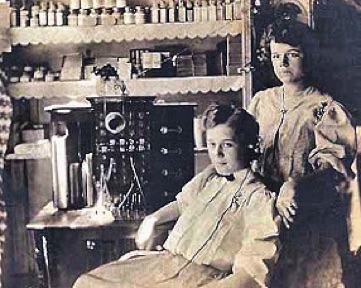
ABOVE: This image (lifted from a 1914 map of Darrtown) shows that the L. A. Miller home was located in the triangular piece of land that is formed by the intersection of Scott Road and the Hamilton-Richmond Pike (St. Rt. 177). The structure still stands today (January 2015).
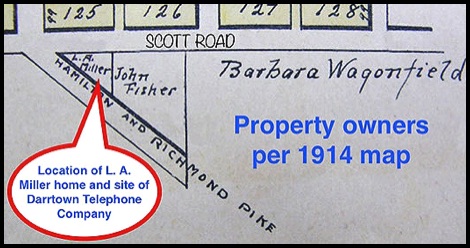
Two Telephone "Toll Tickets" Found
While excerpting the 1935 diary of Mr. L.A. Miller, TWO TOLL TICKETS were discovered.
Throughout Mr. Miller's collection of diaries, he wrote about charging subscribers for telephone "rent" and telephone "tolls."
Presumably, the rent was an amount charged each month for use of a telephone and the service of the telephone lines within the geographical area served by the Darrtown Telephone Company (see image below).
Telephone calls made to areas outside the local service area were called "toll calls" and the telephone company charged an extra fee that was based on the length of each call ... measured in minutes.
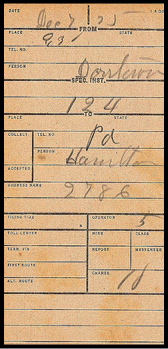
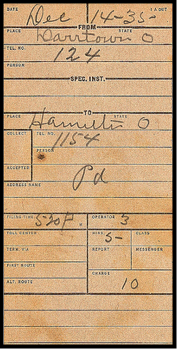
• The two toll tickets were both charged to "Tel. No." 124.
• The ticket on the left, handled by operator #5, was dated December 7, 1935.
• The ticket on the right, handled by operator #3, was dated December 14, 1935.
• The charge for each call was $0.10.
Probable area served by the Darrtown Telephone Company
From Mr. Miller's description of work performed at different locations in and around Darrtown, it seems reasonable to conclude that the Darrtown Telelphone Company provided service to the area depicted in the illustration at the right.

Telephone tax bill
The following tax bill was discovered, while excerpting the 1937 L.A. Miller diary.
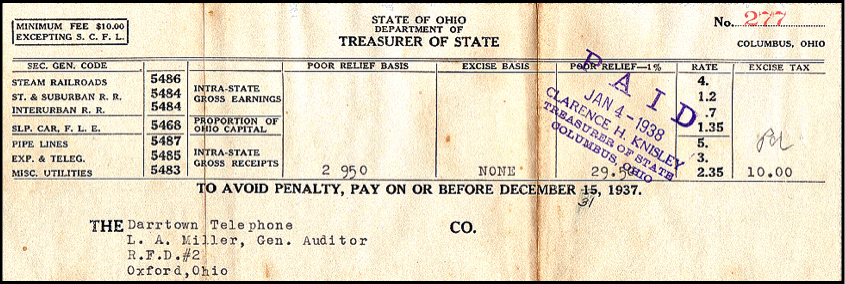
1938 - L. A. Miller joins National Association of Telephone Pioneers
The following image displays a membership form that confirms Mr. L. A. Miller of Darrtown, Ohio as a member of the Telephone Pioneers of America. This form was found in the box that was used to ship a set of L. A. Miller diaries to the Darrtown webmaster in early 2013. To read the story of how the diaries returned to Darrtown, see Families / Miller, L. A. / Diaries - background.
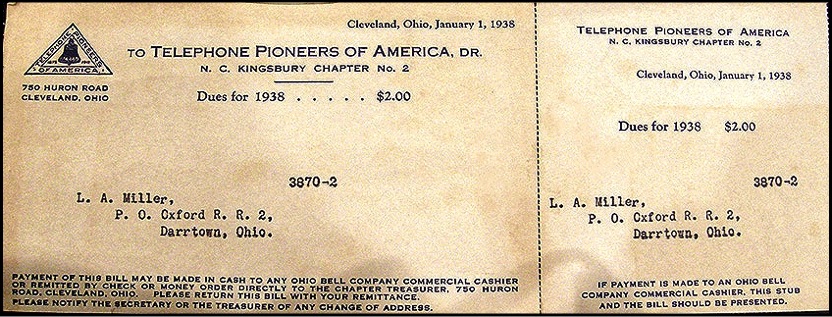
1941 - Darrtown Telephone Company Sold
Oxford Company Takes Over Assets Of Exchange Operated By Millers
From the Hamilton Daily Journal News / Nov. 24, 1941 / pg. 1
"The Ohio Standard Telephone company of Oxford has purchased the assets and stock of the Darrtown Telephone Company, it was announced Monday, in Oxford, by William Clemons, district manager of the Oxford company. At present, operation of the Darrtown company is unchanged. After the public Utilities commission of Ohio approves the sale, expected in 60-90 days, the exchange will be moved from Darrtown to Oxford and the Darrtown subscribers will be placed on the rural service of the Oxford company. Until the utilities commission approves the sale, Hamilton calls to Darrtown will be handled as previously. After P. U. C. O. approval, Hamilton calls will be routed through the Oxford exchange. The Oxford company purchased the Darrtown company from E.L. Miller and Son, operators of the exchange for many years."
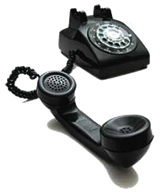
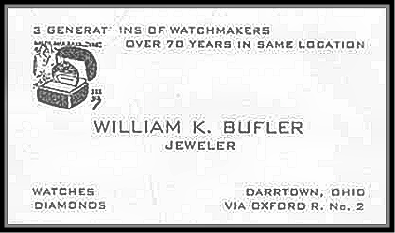
Bufler's Jewelry, located at 4233 Main Street in Darrtown, has been owned and operated by a Bufler for over five generations. During the early to mid-20th century, the jeweler/watch-maker in charge was one William K. "Bink" Bufler.
The following story and accompanying photos appeared in a newspaper clipping provided by Mr. Bufler's son, Dale Bufler.
"Family Has 'Time on Hands' for 3 Generations
By Elsa Simpson
Darrtown, O., Feb. 13
In his watchmaker's shop, where the timepieces tirelessly tick off the days and months and years, William K. Bufler plies a skill his grandfather brought from Germany three generations ago.
The Buflers have had 'time on their hands' for well over a century and grandfather, father, and now son passed the special skill along. As antique clocks chimed the hour and the cuckoos raucously popped in and out, Bufler, now 66, sat at the workbench his grandfather used when he came to Darrtown as a stripling of 20.
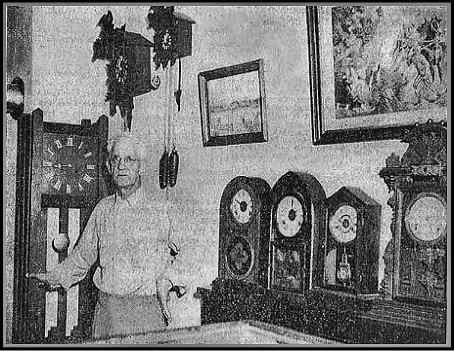
'It's the kind of business you have to grow up with to be really good at it,' the white-haired watchmaker said. Bufler’s shop is crowded with beautiful old clocks of all sizes and shapes, a collection of key winder pocket watches, antique jewelry, and even eyeglasses like Ben Franklin and George Washington wore. None of them are for sale, he says, unless somebody should happen to offer 'an awful price.'
Grandfather Frank Bufler used to have his shop in the living quarters of the house and the boards still are grooved where he sat over his worktable. Father Joseph Bufler, who operated the shop all his live, has been dead 43 years. He built the present shop on a wing of the house. Bufler still has a pocket watch his father made by hand.
He has old chain-driven watches and the kind that Abe Lincoln carried. The old clocks have wooden works and run on weights.
'If I’d sell my old clocks, the money would be gone and then what have you got,' he commented. He says the chorus of ticking of all the clocks doesn’t bother him at all. He doesn’t even notice it.
.
He remembers Darrtown when it was an active little town with a hotel, blacksmith and wagon-maker shops, a saw mill, and four saloons.
'There used to be a race track over that way,” he said, pointing across the main street. 'Darrtown used to have a post office, too and the toll road went through here.' He said many of the old timers are gone, but there are still a few, such as the Kigers and the Ramseys.

ABOVE: William K. Bufler, Darrtown watchmaker, his jeweler’s glass in place, bends over the same workbench used more than a century ago by his grandfather. Bufler’s Jewelry is the oldest business in Darrtown and among the oldest in the county.
'I remember when they used to drive a team of horses to Oxford to get the mail for the post office,' he said. He believes the town receded more rapidly than normal, after the Darrtown school was closed and the youngster consolidated with Oxford. Bufler said the Fisherman Press office building, now under construction, is the first commercial construction that he can remember.
Just about four years ago, the watchmaker drifted into a new avocation when his daughter was painting one of those numbered pictures and had some paint left over. He started dabbling with the leftovers and soon had a number of oil paintings, two of which hang on the shop wall. They have a distinctive touch of craftsman and a sort of individualism as rare anymore as good watchmakers."
Teckman Trucking
Harry Teckman began his trucking experience as a driver for Charles Meeks in Seven Mile, Ohio (circa 1920).
After Harry established his own trucking company, his business expanded to the point that he operated five or six trucks and at one time employed eight drivers. Teckman Trucking transported a wide variety of products, including milk, beer, grain, gravel, lime, and livestock.
The milk hauling business involved picking up fresh milk daily from farmers on three routes in Butler and Preble counties, Ohio and transporting it to Hamilton, Ohio for processing by dairy plants. During one winter, Teckman Trucking hauled cream from Hamilton to Washington D. C. (two drivers alternated on this route; one driving, while the other one slept).
The following narrative was written by Charles Teckman, son of Harry Teckman.

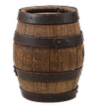



In the 1930’s, Teckman Trucking delivered kegs, barrels, and cases of beer from Cincinnati to Cleveland and St. Louis. Harry stopped hauling beer in 1941 or 1942.
To augment his grain-hauling business, Harry outfitted one of this trucks with a corn sheller that was powered by the truck’s PTO (power take-off). Ears of corn were shoveled into the sheller and the kernels of corn were separated from the corn cobs. Dick Bufler and Earl Young were two Darrtown residents that Harry hired to shovel the corn.
Webmaster note: Another piece of history regarding the Teckman Trucking Company is provided In the "Recollections of R. Kirk Mee II." Mr. Mee's thoughts about Teckman Trucking appears at the right.
"Prior to 1913, when we had the big flood in the Miami Valley, the farmers in the area brought milk to Edward Teckman, and he delivered it every other day to Hamilton by horse and wagon. Around 1920, he bought two Federal trucks. Federal was the name of the truck; not government trucks. His sons, Harry and Louis, took over the trucking business. Harry bought Louis out and he got a big old chain-drive Kissell truck. He used it as a stock truck to haul livestock to Cincinnati. He applied and received one of the very first PUCO, that's Public Utility Commission of Ohio, licenses to truck. He carried on this trucking operation until he died in 1970 or so.”
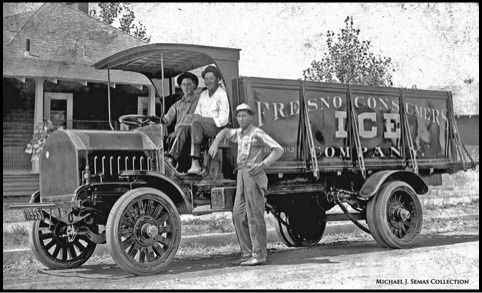
Webmaster note - Mr. Mee mentioned (above, right) that Harry Teckman once owned a "chain-drive" Kissel truck. The image at the right shows such a vehicle. The drive chains are visible in this image; one for each of the rear wheels.
The Internet reports that Louis Kissel and his two sons engaged in the production of chain-driven cars, in 1916. They began building trucks during WWI; see Kissell Motor Car Co.
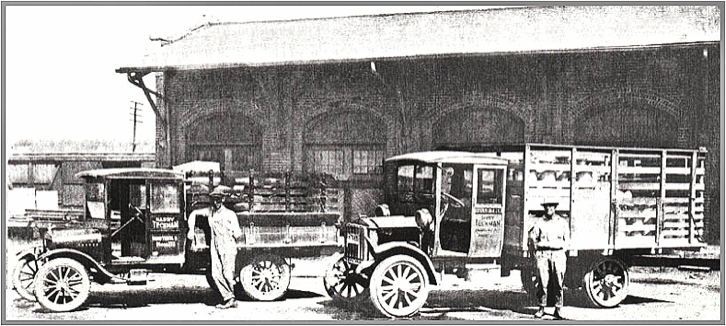
RIGHT: In this photo, Harry Teckman is shown standing beside the truck at the right. Ellis "Dugan" Glardon is shown standing by the truck on the left. The building behind the trucks is reminiscent of the Hamilton, Ohio railroad depot (and a train car appears at the left, behind the darker, smaller truck).
Items of note about BOTH trucks:
> the milk cans within the truck beds;
> the absence of bumpers at the front of the trucks;
> the wheels with wooden spokes;
> the (apparent) horizontal railing above the doorway/entrance to the truck cab suggests that the doors may have been designed to slide, rather than hinge.
Items of note about the SMALLER truck:
> the slanted sideboard that Ellis is leaning against (which suggests that the smaller truck was used to haul loose material, such as gravel or grain and the side racks were probably removable);
> the lower portion of the front windshield appears to be slanted inward, presumably to allow air to flow into the cab.
Items of note about the LARGER truck:
> the location of the headlights (separate from the front fenders; close to the truck cab);
> the interior of the engine compartment is visible, suggesting that the side cover has been removed or has been opened and temporarily placed on the top of the hood;
> the rectangular object at the front of the radiator on the larger truck, which might be a license plate;
> the location of the rearview mirror on the larger truck (near the top of the doorway).
> the similarity between this truck and the Kissell chain-driven truck that appears in the example photo above. Thanks to the recollection of Kirk Mee II (above), it seems logical to identify this truck as the "big old chain-drive Kissell" truck that Harry acquired after buying out his brother's half of the trucking business.
Conversations with people who lived in or near Darrtown during the 1930s have included references to a Cartwright - Uhl Trucking company. We seek information about and photographs of Cartwright - Uhl Trucking; if you have any to contribute, please contact the Darrtown.com Webmaster.
Officers included:
Phil Wheeler, President
Marvin Puckett, Vice President
Jack P. Snyder, Treasurer
Beatrice Caldwell, Secretary
Staff members included:
George S. Fichter, Editor
I.M. Lindsey, Associate Editor
Edwin Fulwider, Art Editor
George Hoxie, Picture Editor
J.P.Snyder, Business Manager
Phil Wheeler, Publisher
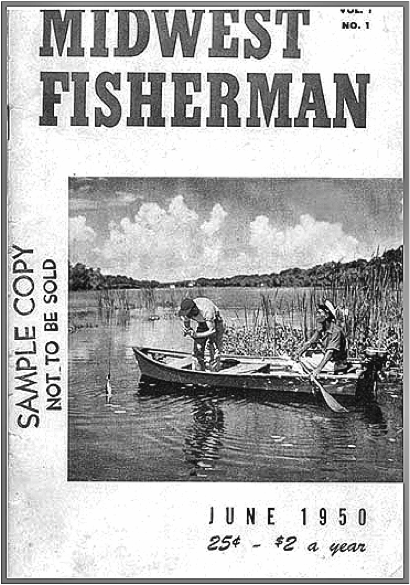
BELOW: This image displays the first two inside pages of "Volume 1 No. 1." Click the lnk below the image to see it enlarged.
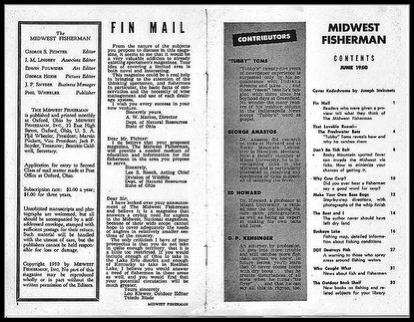
Faces at the Fisherman Press
In October 2013, Helen (Wills) Marchant contributed the five images (right and below) and the names of those identified in the photos.
if you have more info about these photos and/or the Fisherman Press, please use the "Contact Me" link at the bottom of this page to communicate with the Darrtown.com webmaster.
ABOVE: (L-R)
Helen Wills, secretary and Bob McHenry, Advertising Director
ABOVE: (L-R)
Kneeling in front: George Fichter, editor
Back row - center: Roy Wills, art work
Back row - right: Phil Wheeler, plant manager
Above and immediate right: unidentifed workers
At the far right: Bea Caldwell
From the Hamilton Daily News - August 17, 1958
"Fisherman Magazine Suspends
Publication Issued At Nearby Darrtown Began 6 Years Ago
The Fisherman magazine, with editorial offices in Darrtown and one of the nation's leading publications on fresh and salt water fishing, has ceased publication, effective with its August issue, it was reported here today. High operating costs is the reason reported for the action.
Having a circulation of more than 300,000 copies at the time the publication suspended, the magazine began nearly six years ago, as a regional publication in Darrtown, serving the fishing enthusiasts of the midwest.
In the following year, the magazine enjoyed considerable growth, and New York offices were established.
Issued by Fisherman Press, Inc., the publication was the only major writing in the country devoted exclusively to sport fishing.
Staff of Fifty
A new building was erected by the publishers early in 1957, and the staff at Darrtown grew to an estimated 50 persons.
Early in July, 1958, personnel at the Darrtown offices reportedly received notification that dismissal was imminent, and there were reports that the firm was attempting to re-finance its operations or sell its subscription lists to other publishers.
The report of the magazine's demise said the New York personnel was terminated on July 23 and that the Darrtown working staff had been reduced to 12 persons. The firm will continue its commercial printing operations.
Today's report also indicated that the firm is continuing its attempt to sell the subscription lists of the magazine to another publishing house.
A number of Hamilton and Oxford residents were employed at the Darrtown offices."
RIGHT: This image shows the "new buiding" mentioned in the 1958 Hamilton Daily News article above.
The former Darrtown High School building, which can be seen at the left-background, housed the presses and publication materials.
RIGHT: This 2012 image shows the former Fisherman Press property when it served as the Darrtown Baptist church.
As one Darrtown company closed its doors in late 1950's (see the Fisherman magazine story above), another Darrtown company was about to launch.
Many in the Darrtown area know that, Joe Pater and wife, Janet (Finkbine) Pater, organized and ran a foundation repair company, known as Kellin, Inc.
Fewer people recall that, while still a teenager, Joe launched his entrepreneurial career with his "Dit Dot Paint Company."
The image at the right illustrates how Joe started down the path of self-employment. Buying a beat-up, 1937 Chevrolet pickup (something like the one seen in the image) for around $50 and borrowing money for supplies, Joe employed some buddies and began painting exteriors of barns and other out-buildings in the Darrtown area.
And, as often said, "the rest is history."
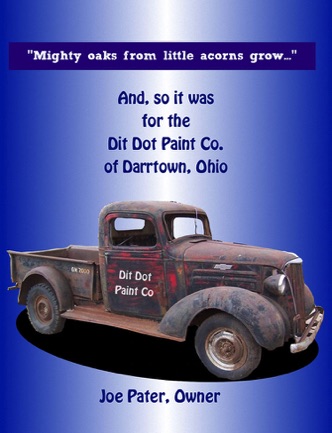
The image at the right displays a business card from the Bufler Jewelry.
√

1899: Darrtown Telephone Company incorporated; see...
1900: Mr. Frank S. Bufler and Mr. John F. Mee applied for right of way for area telephone lines.
1928: Mr. Bufler and Mr. Mee sold the Darrtown Telephone Company to Mr. L. A. Miller.
1941: Mr. Miller sold Darrtown Tel. Co. to the Ohio Standard Telephone; see...
Webmaster Note: Click the link below to see a 1926 newspaper advertisement item that confirms the presence of in-home telephone service to the northern part of Milford Township ... assuming that the letter "N" in the telephone exchange number (22N) indicates "north."
Below, see a link to a 1922 newspaper advertisement for Teckman Trucking.
BELOW: Click these links to access an article about the Fisherman Press moving to Darrtown.
BUSINESSES 2. The Hitching Post (plus, links to Darrtown/Milford township tavern history).
RIGHT: This image of a 1955 Dayton newspaper article provides background information about the Fisherman Magazine. Click the following link to enlarge your view of the Fisherman Press Early Years article.

We are indebted to Rick Martin for contributing this copy of the "MidWest Fisherman" magazine.
RIGHT: This image displays the cover page of the first publication of the "Midwest Fisherman," which was produced by Midwest Fisherman, Inc. and copyrighted in 1950. Note that this "Sample Copy" is marked "Not to be Sold" and is designated (in the upper right corner of the cover page) as "Volume 1 No. 1."
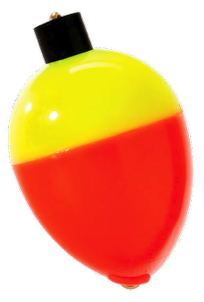
Known locally as "Fisherman's Press," the Midwest Fisherman company operated out of the former Darrtown High School building during the 1950's.
Darrtown,
Ohio
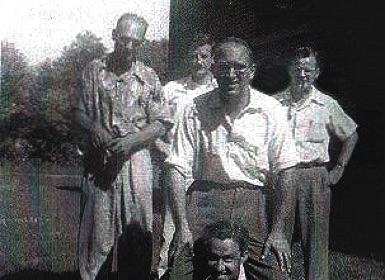
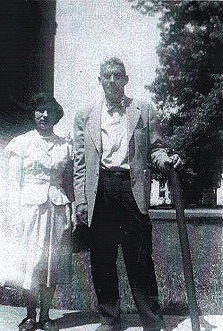


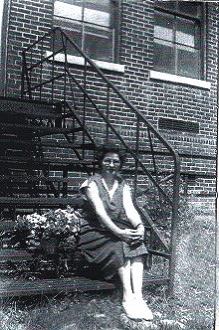
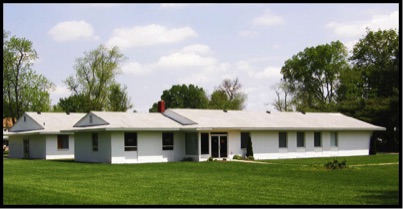

Telephone Company Truly Independent
The Independent Telephone Company of Darrtown is really an independent telephone company, with one family in charge of installations, operation, servicing, and billing.
The exchange is located in a home [1]; the telephones are of the crank, call-box type; and the phone bills are often paid with corn, hogs, and other produce of the country-side.
L. A. Miller is the founder, owner, and operator of the system, which has 85 subscribers, although it did once reach a peak of 110. His son [2] helps him and his wife [3] often works the exchange switchboard.
Miller built the first line, a three-mile stretch, to the home of R. Kramer, a farm neighbor, [4] who paid a month for the single wire connection. The line worked.
Miller and his son began to dig post holes, erect poles, stretch wires, and generally drum up trade. The son went down to Cincinnati to get some experience with a large phone company and then returned to add the benefit of his knowledge to operating the home line.
Now the system stretches over 64 square miles, in this vicinity.
The company was originally formed on a congressional charter grant in the '90s, with Fran Beam of Mt. Vernon, elected president.
Miller recalls that after the first successful line was installed, it took a great deal of persuasion to have his neighbors install the "new-fangled contraption" in their homes.
Nor has the recent business recession helped him any, Miller says.
Those hogs, though, he received for phone bill payments, may help.
Born in Vigo County, [5] Indiana, and graduated from Central Normal University in Danville, Indiana, he taught schools in Butler County, Ohio for 26 years. At one point, he was principal [6] of the Darrtown schools. Later, he was a fur buyer and trader."
"PAY PHONE BILLS WITH HOGS, CORN, ETC. FOR TRULY INDEPENDENT DARRTOWN CO.
Mr. Miller's diaries include references to employing the "Weiss girls," as switchboard operators. The Miller diaries include multiple references to the switchboard being located in the Miller home.

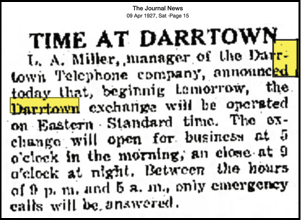
RIGHT: This April 1927 news clipping reported the hours that the Darrtown Telephone Company switchboard would accept and process phone calls.
To see a transcript of this news item, click the following link:
The Journal News – April 9, 1927 – Page 15 TIME AT DARRTOWN L. A. Miller, manager of the Darrtown telephone company, announced today that, beginning tomorrow, the Darrtown exchange will be operated on Eastern Standard Time. The exchange will open for business at 5 o’clock in the morning; and close at 9 o’clock at night. Between the hours of 9 PM and 5 AM, only emergency calls will be answered.
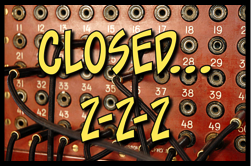
1926 - Duplicate of Six Dollar Check Discovered
Re-issued check found while excerpting Mr. L.A. Miller's 1926 diary
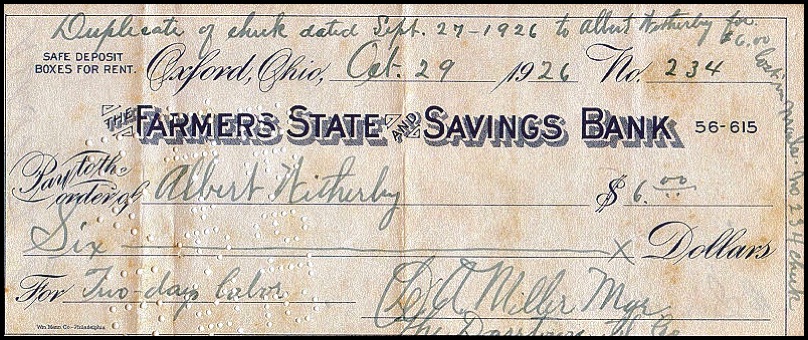
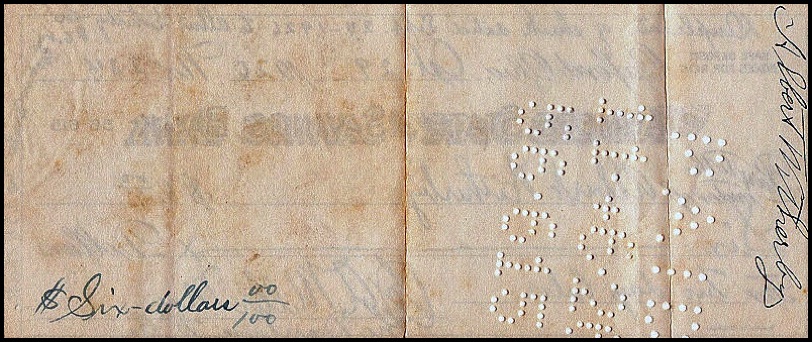
An internet source calculates that six dollars in 1926 would be worth about $123 in 2024.
Click the links below the images to see them enlarged.
The Darrtown Telephone Company, during much of the summer of 1926, was engaged in moving existing telephone lines to accommodate the widening of State Route 177 and State Route 73. The reconfiguration of the two highways was being done to comply with the state right-of-way. Mr. MIller employed several local residents to assist with the digging of holes for the relocation of telephone poles. Mr. Miller's September 1st diary entry included this notation: "Albert Witherby has helped yesterday and today at per day."
The following images show a canceled check that was paid by the Darrtown Telephone Company to Albert Witherby for "two days labor." This check, according to the hand-written note at the top of the check, was a duplicate of an earlier check that was lost the mail.
Note that the check was signed by "L. A. Miller, Mgr." - i.e., Mr. Miller did not own the telephone company in 1926. He purchased the Darrtown Telephone Company from Mr. Bufler and Mr. Mee, in 1928. This document provides the signatures of Mr. L.A. Miller and Mr. Albert Witherby (who was approximately 34 years old in 1926).

1927 - Switchboard Hours of Operation Announced
BUSINESSES 1. Reeb's store; Bufler's grocery, another Bufler store; Stevens' grocery, Francis' gas station, Wyckoff's grocery; Dees grocery and gas station; Glardon's grocery; and Don's Carry-Out.
